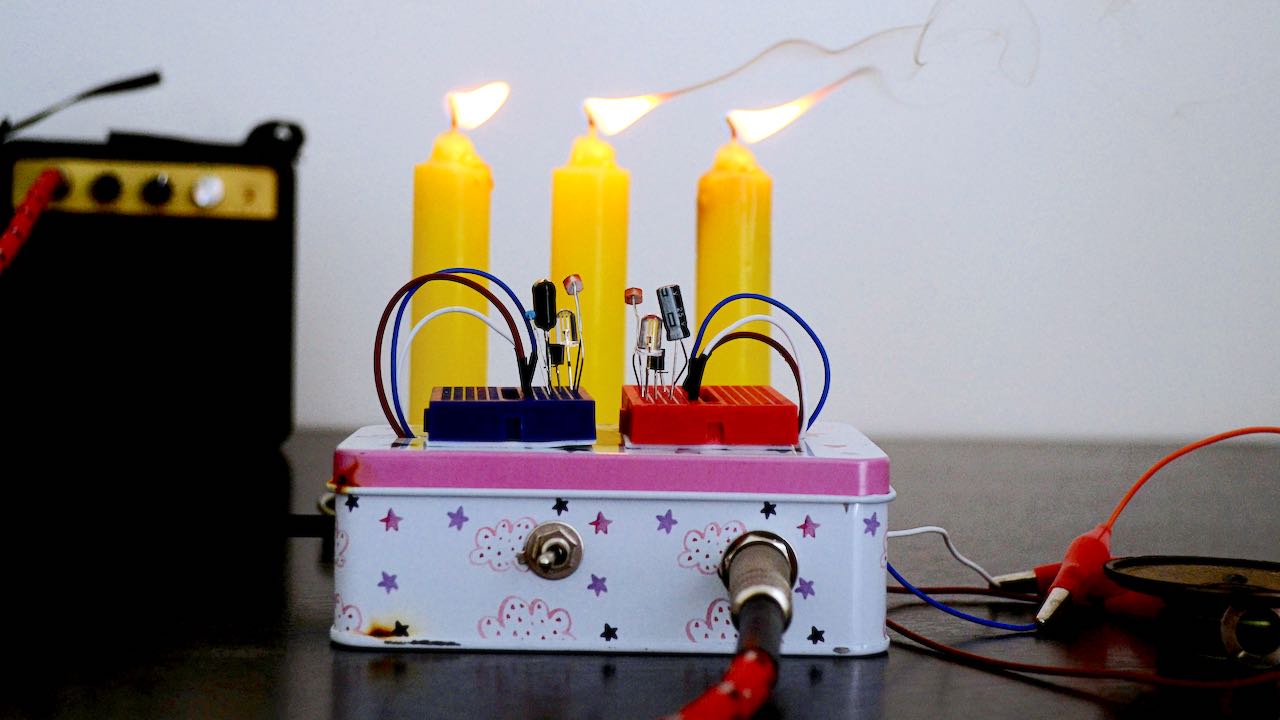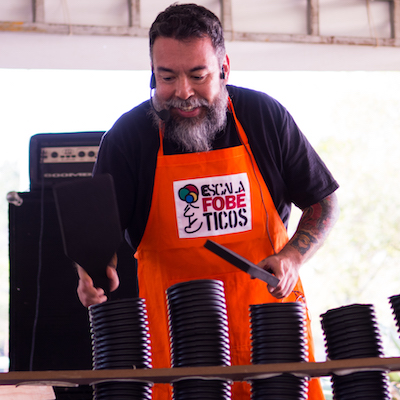Creatures of light
Simple, five-component circuit that reacts to light and produces sounds according to the intensity of the light. It is like a simple luminous theremin.
 The idea of this instrument arose from a series of instruments that I have been thinking about as living with the coronavirus that imposed new ways of living in society, with social distance and fear of contamination. These new instruments have the challenge of being played by the forces of nature, such as wind, water, fire and light, without the need for human interaction for them to produce their music. This particular project can be played by humans, but without the need for physical contact with the instrument.
The idea of this instrument arose from a series of instruments that I have been thinking about as living with the coronavirus that imposed new ways of living in society, with social distance and fear of contamination. These new instruments have the challenge of being played by the forces of nature, such as wind, water, fire and light, without the need for human interaction for them to produce their music. This particular project can be played by humans, but without the need for physical contact with the instrument.I started from the inspiration of Theremin, with the objective that public school teachers could learn to build it without great difficulties, so I simplified the circuit to the maximum. The circuit consists of:
1 transistor 2N3904
1 resistor 1Kohm
1 capacitor 10uF
1 LED
1 LDR
2 9v Battery
1 small speaker
1 Mini Protoboard
The transistor, when powered by two 9v batteries, produces an oscillation that allows us to hear it and is modulated by the light-dependent resistor (LDR). It would be like a volume or tone control of a stereo, which rotates this way and that with the incidence of light. In this circuit, the LDR controls the height of the frequencies emitted by the transistor.
For this exhibition, I used colored lights emitted by a RGB LED lamp in a random way and candles to demonstrate the possibilities and variations of the sounds according to the different lights emitted.
Frequently Asked Questions
What inspired you to do this?
I have been researching the possible songs of the elements of nature, such as water, wind, fire and light and thinking about ways to produce musical instruments that do not require the physical contact of the instrumentalist with the instrument, inspired by the rules of social distance imposed by global coronavirus pandemic.
How long did it take to make it?
The whole research has been maturing since March 2020. I started with instruments touched by the wind and embarked on the search for possibilities with light. Among the discoveries of affordable electronic components and a stable assembly, it took me about three months.
How long have you been doing things like this?
about 7 years.
How much did this cost to do?
About $10 USD.
Have you done other things like this?
Yes, the research continues with other possibilities with the wind and the lights. Recently I have been researching the possibilities of making music with water. In addition to the instruments I already build using everyday objects and scrap.
Are there plans available to make this? Do you sell this?
Yes, I can share the circuit design for free. The idea is that everyone can use this resource in their own projects and build sound and visual experiments with children. I believe that the world today needs more art.
What’s next?
To continue researching the sounds and musical possibilities of nature, incorporating them in my band called Escalafobéticos and being able to share this information and ideas with educators, schools, parents and children through workshops and educational concerts.
Mauro Tanaka
: Sound Artist, Luthier, Musician, Educator

In our family, we have always had a garage workshop with many tools at our disposal. I remember building my own toys and doing lots of experiments. When I started studying music at the age of 11, I was immediately attracted by the curiosity about how musical instruments are built. I studied organology and conventional string instrument luthiery. I built some guitars and I still have a repair shop for guitars, ukuleles, cello, violin, electric guitars and basses. When I became a music educator, I came across a very adverse reality in public schools in Brazil, with many problems of socioeconomic vulnerability. Almost no school had music education in its curriculum due to the lack of musical instruments. It was there that I had the idea of joining my knowledge of conventional luthiery, with my childhood creations and started to research and build musical instruments with everyday objects, with scrap and with the reuse of toys and circuits. I have been working with this alternative musical instrument project for about 7 years. My influences are some Brazilian researchers like Walter Smetak, the musical group Uakti, GEM and the icons of the experimental world luthieria like Luigi Russolo, brothers Baschet, Harry Partch and John Cage.
Connect with Mauro Tanaka
How I can help you:
I have experience with the creation of instruments using scrap and everyday materials both for performance on stage and in schools with children. Something I've been doing here in Brazil, and that may be of interest to other people around the world, is to help teachers and parents who want to create instruments with children and need help.
I have experience with the creation of instruments using scrap and everyday materials both for performance on stage and in schools with children. Something I've been doing here in Brazil, and that may be of interest to other people around the world, is to help teachers and parents who want to create instruments with children and need help.
How you can help me:
The more people can be part of a network connected with this idea of making art with alternative materials and concepts, the better. If my ideas can be shared with as many people as possible, it would be wonderful.
The more people can be part of a network connected with this idea of making art with alternative materials and concepts, the better. If my ideas can be shared with as many people as possible, it would be wonderful.